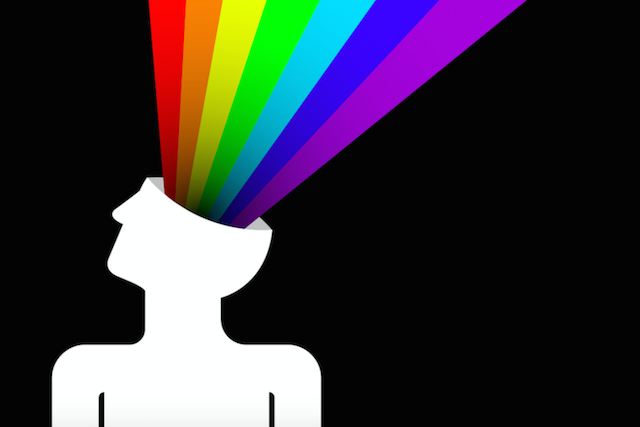
“As you sow in your subconscious mind, so shall you reap in your body and environment.” ~Joseph Murphy
The subconscious mind is like a computer’s hard drive.
It saves whatever information you feed it, without any bias. It does not discriminate between useful information and trash information. It just saves everything!
The subconscious mind learns through repetition. So if it’s fed the same information multiple times, it keeps overwriting it until the information gets etched in.
As you would have guessed, such information is harder to erase.
For example, let’s say you write “I am not good enough” on a piece of paper. Now keep overwriting on top of this. The more you overwrite, the bolder the text becomes and the harder it gets to erase it later.
Let’s look at another example. When you first learned to ride a bicycle, you found it hard to balance. But you kept trying and could maintain balance for five seconds and then ten seconds and so on. Finally you could maintain balance for longer periods of time. Because of the repetitions, your subconscious mind picked up what it takes to maintain balance.
Once the subconscious mind learns, it falls back on this information whenever it is required.
So the next time you sit on a bicycle, the subconscious mind automatically switches on the default bicycle-riding program and without any effort, you start to ride your bike.
What is interesting is that if you learned to ride the bike in a faulty manner, you will keep riding the bike in a faulty manner.
For example, there are people who find it difficult to drive a car while wearing shoes. They can only drive the car barefoot! This is because when they were learning to drive, they did so barefoot. How do I know? Well, I am one of them!
For me, learning to drive a car while wearing shoes was like learning to drive the car all over again.
So what does this tell you?
Once the information is fed to the subconscious mind, and is repeated enough times, it simply gets etched in the mind and is hard to erase later.
Yes, it is erasable, but erasing it would require extra effort. This is exactly the reason why bad habits are so difficult to break. And this holds true for both physical habits and mental habits.
Physical habits equate to stuff that you do. Like your daily routines.
Mental habits are thought cycles like your self belief, your insecurities, your view of the world etc.
In a way, your mental habits fuel your physical habits and vise versa. It’s cyclic in nature.
Rewriting Negative Subconscious Programs
As mentioned earlier, your subconscious mind is like a computer’s hard drive. And just like we can erase and put new software into a hard drive, we very well can reprogram data into the subconscious mind.
Hypnotists have been doing this for ages.
But the technique we are going to look at is far stronger than hypnosis. Plus it is very simple to do. In fact, the technique is so simple, you might be forced to think, is that it?
So let’s see what this simple technique is.
The best and most effective technique to alter your negative subconscious mind patterns is awareness.
That’s right, you simply become aware of the subconscious patterns.
Once you become aware, the additional actions required to make the change follows automatically.
Becoming Aware of Subconscious Mind Patterns
Subconscious mind patterns are called subconscious for a reason. They are below (sub) your level of consciousness. In other words, you are not consciously aware of them.
For example, I used to have the habit of shaking my leg non-stop when sitting down, also known as restless leg syndrome. It would be many minutes, sometimes even hours before I would become aware that my leg was shaking and I would stop doing it. But moments later when my attention shifted to something else, my leg would start shaking again.
What helped me eliminate this issue was to develop body awareness. I started to become more and more aware of what my body was doing at any given point. So whenever my leg would start shaking, I would become aware of it within a few seconds as opposed to many minutes like before.
Over a period of time, the shaking stopped. I still do it occasionally but it is very rare. And each time I can catch myself quickly and stop doing it.
Body awareness not only helped me tackle this issue, it also helped me become aware of tense body parts so I could relax them more often.
For instance, I noticed that whenever I worked on my computer, the muscles around the base of my skull (known as the suboccipital muscles) would tense up badly. This would cause fatigue, headaches, and back pains. Body awareness helped me sense this and consciously relax my muscles whenever that happened.
This is just one very small example of how you can overcome a subconscious habit by becoming aware of it.
This habit is easy to catch as it is happening on a physical level. But there are many mental habits that happen on a mind level. You cannot see them; they just happen.
For example, just like me, you might have the habit of judging others. The strange thing is that the judging happens automatically. The problem with this habit is that you not only judge others, you judge yourself too. It always works both ways. Also, what you perceive of the other can be massively different from reality because you perceive from your own belief system.
The way to become free from this habit is, again, to become aware of your thinking patterns.
As you become more and more aware of your thinking patterns you will be able to catch your mind judging others. As you catch yourself judging, you do not blame yourself or force yourself to stop; you simply become aware of it—“Ah, here I go, I am judging again!”
As you continue to do this, slowly but surely, your judgments of other people will start to reduce.
Developing a Deeper Awareness
Awareness is a habit and the more you practice it, the more it becomes second nature. I find the following four techniques to be extremely useful in developing awareness of your physical and mental processes:
1. Consciously watching your thoughts
In our day-to-day life, we are lost in our thoughts for the most part. The goal is to detach from your thoughts for a few moments and watch them as a neutral observer.
This practice can help you become aware of negative thought patterns. You will find yourself questioning your beliefs and thereby weakening negative beliefs and consciously replacing them with positive ones.
Here’s what you can do:
Sit comfortably, take a few deep breaths, and calm yourself down. Start to become aware of your mind producing thoughts without engaging with them. If you find yourself getting engaged with the thought, take a moment to acknowledge that and return back to watching.
If certain thoughts produce strong emotions in you, feel the emotions instead of trying to suppress the thoughts. Divert your attention within your body and feel the energy behind these thoughts.
As you watch your thoughts, you will become aware of many negative thought patterns running in you. Simply becoming aware of these patterns is enough for them to start disintegrating.
2. Consciously feeling your emotions
Becoming aware of your emotions helps you understand the thought-emotion connection—in other words, what kind of thoughts produce what kind of emotional responses in your body.
This can help you weaken and release the hold of strong negative emotions.
What I find works best is to consciously recreate emotional responses when you are by yourself.
Let’s say certain situations cause strong anxiety in you.
For example, there were times when simple things like walking into a crowded restaurant made me feel anxious. There was this feeling that everyone is looking at me and judging me negatively, and that thought gave rise to a set of emotions that clouded my thinking and made me feel extremely anxious and unwelcomed.
When you are in such a situation, it is hard for the untrained mind to do anything. But there is a workaround. You can use this situation to train your mind when you get back home.
When you are back home, you can sit down in a calm place and recreate that exact scenario by running it in your mind. Doing so will evoke pretty much similar emotions. This time though, instead of being lost in your thoughts and overcome by the emotions, you have a choice to consciously feel your emotions. Feel them fully as they arise without becoming afraid of them. As you feel your emotions this way, they start to lose their power over you.
What you are doing here is becoming aware of thought patterns and the reactions they create in your body. This awareness slowly starts to dissolve existing thought patterns and their corresponding emotional responses.
Next time you visit the same restaurant, you will be aware when certain thoughts start getting generated and your body’s emotional response. But because you have already felt your emotions consciously and because you are aware of your thought patterns, you will find that they have significantly weaker reactions. Continue this and soon the reactions would die down completely.
3. Consciously feeling your body
Becoming aware of your body can help you learn how to relax your body and thereby aid healing.
For example, you might have body parts that tense up when you are engaged in work or some activity. For me, as I mentioned before, it was the back of my head and the suboccipital muscles (muscles near the base of the skull) that tensed up when I was engaged in work.
This would lead to extreme headaches and back pain and would cloud my thinking, leading to frustration. It was only after I started becoming aware of my body that I could feel these muscles all tensed up and relax them consciously. I had to relax them consciously many times over while working and after a few months they automatically started to stay relaxed.
A simple technique you can use to become aware of your body is to feel your body from within during a meditation practice. Simply feel the inside of your body starting from the soles of your feet to the tip of your skull. As you scan your body this way, find and relax various tension points along the way. If you find certain parts aching, spend some more time there and relax these parts.
Relaxing your body is key to healing. The more relaxed your body feels the more rejuvenated you will feel. This exercise is best done before going to sleep, so you feel fresh and rejuvenated when waking up. In-fact, you can do this lying down in bed.
Getting in touch with your body can also help you better feel and release your emotions.
4. Consciously focusing your attention
In any given point of time, our attention is divided between a myriad of things. Most of us don’t have any control over our attention. It just wanders like a wild beast anywhere it wants to go.
This method will help you gain control over your attention. The more control you have, the better you will be able to practice the above-mentioned methods.
For instance, you can feel your emotions for longer periods of time without getting pulled into thinking. Similarly, you can watch your thoughts longer without getting lost in the thoughts often. You can also stay mindful for longer periods of time.
There was a time I found it extremely difficult even to read a few paragraphs of an article. Within just the first few lines, my attention would drift away into my thoughts. I would be reading, but not understanding anything. I would then have to re-read the lines again. This is what happens when you don’t have mastery over your attention.
And the most effective way I found to gain mastery is focused meditation. All it involves is to divert your attention to your breath and keep it there for as long as possible. If your attention wanders, bring it back again. As you keep doing this practice, you will start to gain control over your attention and your ability to focus.
—
These four methods are the gateway to deeper awareness. They can be practiced together or separately, depending on what you find beneficial at the moment. I believe these techniques can help anyone become free from low self-worth, limiting beliefs, anxiety, depression, and all other types of issues related to the mind.
About Mukesh Mani
Mukesh writes on various topics related to consciousness, self-healing, relaxation, meditation, mindfulness, subconscious mind, and body awareness. You can find his articles on outofstress.com and on his personal blog consciousreset.com.













 Though I run this site, it is not mine. It's ours. It's not about me. It's about us. Your stories and your wisdom are just as meaningful as mine.
Though I run this site, it is not mine. It's ours. It's not about me. It's about us. Your stories and your wisdom are just as meaningful as mine. 